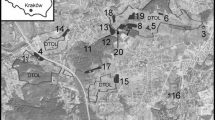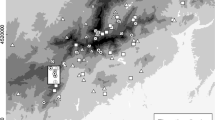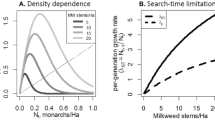Abstract
Habitat fragmentation is considered to be one of the main causes of population decline and species extinction worldwide. Furthermore, habitat fragmentation can decrease the ability of populations to resist and to recover from environmental disturbances such as extreme weather events, which are expected to occur at an increasing rate as a result of climate change. In this study, we investigated how calcareous grassland fragmentation affected the impact of the climatically extreme summer of 2003 on egg deposition rates, population size variation and survival of the blue butterfly Cupido minimus, a specialist herbivore of Anthyllis vulneraria. Immediately after the 2003 summer heat wave, populations of the host plant declined in size; this was paralleled with decreases in population size of the herbivore and altered egg deposition rates. In 2006 at the end of the monitoring period, however, most A. vulneraria populations had recovered and only one population went extinct. In contrast, several butterfly populations had gone extinct between 2003 and 2006. Extinction probability was significantly related to initial population size, with small populations having a higher risk of extinction than large populations. These results support the prediction that species of higher trophic levels are more susceptible to extinction due to habitat fragmentation and severe disturbances.




Similar content being viewed by others
References
Adriaens D, Honnay O, Hermy M (2006) No evidence of a plant extinction debt in highly fragmented calcareous grasslands in Belgium. Biol Conserv 133:212–224
Adriaens D, Honnay O, Hermy M (2007) Does seed retention potential affect the distribution of plant species in highly fragmented calcareous grasslands? Ecography 30:505–514
Andrén H (1994) Effects of habitat fragmentation on birds and mammals in landscapes with different proportions of suitable habitat: a review. Oikos 71:355–366
Asher J, Warren M, Fox R, Harding P, Jeffcoate G, Jeffcoate S (2001) The millennium atlas of butterflies in Britain and Ireland. Oxford University Press, Oxford
Baguette M, Petit S, Quéva F (2000) Population spatial structure and migration of three butterfly species within the same habitat network: consequences for conservation. J Appl Ecol 37:100–108
Bastrenta B, Lebreton JD, Thompson JD (1995) Predicting demographic change in response to herbivory: a model of the effects of grazing and annual variation on the population dynamics of Anthyllis vulneraria. J Ecol 83:603–611
Brown JH, Kodric-Brown A (1977) Turnover rates in insular biogeography: effect of immigration on extinction. Ecology 58:445–449
Burnham KP, Anderson DR (2002) Model selection and inference—a practical information-theoretic approach. Springer, Berlin Heidelberg New York
Cowley MJR, Thomas CD, Roy DB, Wilson RJ, Léon-Cortés JL, Gutierrez D, Bulman CR, Quinn RM, Moss D, Gaston KJ (2001) Density-distribution relationships in British butterflies. I. The effect of mobility and spatial scale. J Anim Ecol 70:410–425
Eriksson O, Ehrlén J (2001) Landscape fragmentation and the viability of plant populations. In: Silvertown J, Antonovics J (eds) Integrating ecology and evolution in a spatial context. Blackwell Science, Oxford, pp 157–175
Goffart P, Baguette M, De Bast B (1992) La situation des Lépidopthères Rhopalocères en Wallonie ou que sont nos papillons devenus? Bull Ann Soc R Belg Entomol 128:355–392
Hanski I (1994) A practical model of metapopulation dynamics. J Anim Ecol 63:151–162
Hanski I, Pakkala T, Kuussaari M, Lei G (1995) Metapopulation persistence of an endangered butterfly in a fragmented landscape. Oikos 72:21–28
Hanski I (1999) Metapopulation ecology. Oxford University Press, New York
Holt RD, Lawton JH, Polis GA, Martinez ND (1999) Trophic rank and the species-area relationship. Ecology 80:1495–1504
Honnay O, Jacquemyn H, Bossuyt B, Hermy M (2005) Forest fragmentation effects on patch occupancy and population viability of herbaceous plant species. New Phytol 166:723–736
Jentsch A, Kreyling J, Beierkuhnlein C (2007) A new generation of climate-change experiments: events, not trends. Front Ecol Environ 5:365–374
Kenward MG, Roger JH (1997) Small sample inference for fixed effects from restricted maximum likelihood. Biometrics 53:983–997
Kéry M, Matthies D, Fischer M (2001) The effect of population size on the interactions between the rare plant Gentiana cruciata and its specialized herbivore Maculinea rebeli. J Ecol 89:418–427
Krauss J, Steffan-Dewenter I, Müller CB, Tscharntke T (2005) Relative importance of resource quantity, isolation and habitat quality for landscape distribution of a monophageous butterfly. Ecography 28:465–474
Krauss J, Steffan-Dewenter I, Tscharntke T (2004) Landscape occupancy and local population size depends on host plant distribution in the butterfly Cupido minimus. Biol Conserv 120:355–361
Kruess A, Tscharntke T (2000) Species richness and parasitism in a fragmented landscape: experiments and field studies with insects on Vicia sepium. Oecologia 122:129–137
Lambinon J, De Langhe JE, Delvosalle L, Duvigneaud J (1998) Flora van België, het Groothertogdom Luxemburg, Noord-Frankrijk en de aangrenzende gebieden. Nationale Plantentuin België, Meise
León-Cortés JL, Lennon JJ, Thomas CD (2003) Ecological dynamics of extinct species in empty habitat networks. 2. The role of host plant dynamics. Oikos 102:465–477
Littell RC, Milliken GA, Stroup WW, Wolfinger RD, Schabenberger O (2006) SAS for mixed Models, 2nd edn. SAS Institute, Cary
Luterbacher J, Dietrich D, Xoplaki E, Grosjean M, Wanner H (2004) European seasonal and annual temperature variability, trends, and extremes since 1500. Science 303:1499–1503
Maes D, Van Dyck H (1999) Dagvlinders in Vlaanderen-Ecologie, verspreiding en behoud. Stichting Leefmilieu, Instituut voor Natuurbehoud, Vlaamse Vlinderwerkgroep, Antwerpen, Brussel
McLaughlin JF, Hellman JJ, Boggs CL, Ehrlich PR (2002) Climate change hastens population extinctions. Proc Natl Acad Sci USA 99:6070–6074
Meehl GA, Tebaldi C (2004) More intense, more frequent, and longer lasting heat waves in the 21st century. Science 305:994–997
Mouthon J, Daufresne M (2006) Effects of the 2003 heathwave and climatic warming on mollusc communities of the Saöne: a large lowland river and of its two main tributaries (France). Glob Change Biol 12:441–449
Opdam P, Wascher D (2004) Climate change meets habitat fragmentation: linking landscape and biogeographical scale levels in research and conservation. Biol Conserv 117:285–297
Piha H, Luoto M, Piha M, Merilä J (2007) Anuran abundance and persistence in agricultural landscapes during a climatic extreme. Glob Change Biol 13:300–311
Pimm SL, Lee Jones H, Diamond J (1988) On the risk of extinction. Am Nat 132:757–785
Rouault G, Candau JN, Lieutier F, Nageleisen LM, Martin JC, Warzée N (2006) Effects of drought and heat on forest insect populations in relation to the 2003 drought in Western Europe. Ann For Sci 63:613–624
Sala OE, Chapin FS, Armesto JJ et al (2000) Global biodiversity scenarios for the year 2100. Science 287:1770–1774
SAS (2002) SAS 9.1. SAS Institute, Cary
Shaffer ML (1981) Minimum population sizes for species conservation. Bioscience 31:131–134
Singer JD (1998) Using SAS PROC MIXED to fit multilevel models, hierarchical models, and individual growth models. J Educ Behav Stat 24:323–355
SPSS (2003) SPSS 12. SPSS, Chicago
Steffan-Dewenter I, Tscharntke T (2002) Insect communities and biotic interactions on fragmented calcareous grasslands-a mini review. Biol Conserv 104:275–284
Sterk AA, Van Duijkeren A, Hogervorst J, Verbeek EDM (1982) Demographic studies of Anthyllis vulneraria L. in the Netherlands. II. Population density fluctuations and adaptations to arid conditions, seed populations, seedling mortality, and influence of the biocenosis on demographic features. Acta Bot Neerl 31:11–40
Thomas CD, Cameron A, Green RE et al (2004) Extinction risk from climate change. Nature 427:145–148
Travis JMJ (2003) Climate change and habitat destruction: a deadly anthropogenic cocktail. Proc R Soc B Biol Sci 270:467–473
Trenberth KE, Jones PD, Ambenie P, Bojariu R, Easterling D, Klein Tank A, Parker D, Rahimzadeh F, Renwick JA, Rusticucci M, Soden B, Zhai P (2007) Observations: Surface and Atmospheric Climate Change. In: Solomon S, Qin D, Manning M, Chen Z, Marquis M, Averyt KB, Tignor M, Miller HL (eds) Climate change 2007: the physical science basis. Contribution of Working Group I to the fourth assessment report of the Intergovernmental Panel on Climate Change. Cambridge University Press, Cambridge, pp 235–336
Tscharntke T, Steffan-Dewenter I, Kruess A, Thies C (2002) Characteristics of insect populations on habitat fragments: a mini review. Ecol Res 17:229–239
Van Swaay CAM (2002) The importance of calcareous grasslands for butterflies in Europe. Biol Conserv 104:315–318
Verbeke G, Molenberghs G (2000) Linear mixed models for longitudinal data. Springer, Berlin Heidelberg New York
Vitousek PM, Mooney HA, Lubchenco J, Melillo JM (1997) Human domination of earth’s ecosystems. Science 277:494–499
Weeda EJ, Westra R, Westra C, Westra T (1987) Nederlandse oecologische flora. Wilde planten en hun relaties 2. IVN-VARA-EWIN, Hilversum
Young A, Boyle T, Brown T (1996) The population genetic consequences of habitat fragmentation for plants. Trends Ecol Evol 11:413–418
Zabel J, Tscharntke T (1998) Does fragmentation of Urtica habitats affect phytophagous and predatory insects differentially? Oecologia 116:419–425
Acknowledgements
We would like to thank three anonymous referees and Ingolf Steffan-Dewenter for their thoughtful and detailed comments on this manuscript. Jan Butaye, Tom Neels and Eric Van Beek helped with data collection. This research is part of the BIOCORE research project, funded by the Federal Belgian Science Policy. D. A. held a grant from the Flemish Fund for Scientific Research (FWO).
Author information
Authors and Affiliations
Corresponding author
Additional information
Communicated by Ingolf Steffan-Dewenter.
Rights and permissions
About this article
Cite this article
Piessens, K., Adriaens, D., Jacquemyn, H. et al. Synergistic effects of an extreme weather event and habitat fragmentation on a specialised insect herbivore. Oecologia 159, 117–126 (2009). https://doi.org/10.1007/s00442-008-1204-x
Received:
Accepted:
Published:
Issue Date:
DOI: https://doi.org/10.1007/s00442-008-1204-x




